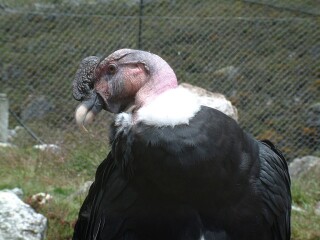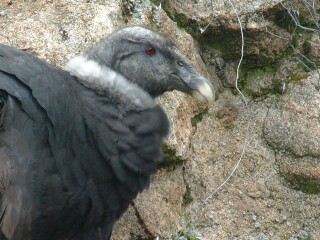

Los Condores Andinos (04-Oct-02)
I looked out the window of the tour-bus, to see winding roads and the Venezuelan Andes. Somehow they didn’t seem so tall, now that I was in them. I made a face, and pulled off my extra long-sleeve shirt. Despite the temperature outside (too cold to be comfortable in only a t-shirt), the van was too warm, and that was making my headache, caused from being 10,000 feet above my usual elevation (sea level), worse. I cracked my window to get some fresh air, and shivered as the cold breeze chilled me. I put the sweater on again.
“Where are we going?” I asked. The bus swerved onto the side of the road and stopped, next to an unpaved side road. I rubbed my forehead. When was that dratted headache going to go away?
“Right here, “ my mom said. “We’re going to see the Andean condors, the largest bird that can fly. Its wingspan is about half the length of this bus. They used to be extinct in Venezuela, no one had seen them here since 1912, but they’re re-introducing them. Come on,” she added as the doors opened. I stared after her as she got out. Bird freak, I thought testily. This headache was making me annoyed at everything.
Eying the bus, I shook my head. It was a good 15, maybe 20 feet long. Wow. As I eased out, I thought, what made them go extinct here? Probably sport, but why not the rest of the Andes? I looked up the hill, and couldn’t see anything that looked like someplace they would keep two birds in captivity. Ay, we have to walk up that whole hill to see some vultures? I thought.
I tried to ignore my altitude-induced headache as we walked up the hill, taking deep breaths and, when we had the extra energy to, looking around at the neighboring hills. In some places, quilt-like squares, obviously farming areas, were bordered in rock walls. In others, we could see what the hillside used to look like, long grass spotted with rocks. Either they use animals to help, I thought, or these people must be really strong. Those rocks are big!
On the other hill, the rocks had been removed, but hadn’t been made into walls. Animals, mainly cattle and horses, were grazing all over. Long grass flowed in the wind like waves, giving the impression of ghosts passing over. I grinned, but stumbled on a rock, and went back to looking where I was going. The air was cool, but I could smell the grass on the breeze. I smiled, savoring it.
The 20-minute walk brought us to a small one-story building, and a caged enclosure with a sign – Condor Andino – and then under it, Vultur gryphus. Inside the enclosure, which seemed too small to my mind, there was a tall rock in the middle, with a lean-to on one side and a little pool on the other. Rocks were scattered all around, and grass was everywhere, short and long.
There were two figures inside the metal mesh. One, sitting on top of the rock, was clearly a bird, although a big one. In the other section of the enclosure, which was, I noticed with some annoyance, less than a quarter of the whole dome was another figure. She was under the lean-to, so still I could have mistaken her for a rock, hidden in shadow, but she was there. I could only identify her from her silhouette, so similar to the one sitting out in the open. The one on the rock, however, had something on top of its head. The male, I thought.
As the male flew, or made a wing-assisted fall is how I saw it, down from the rock and displayed his wings before tucking them neatly behind his back, I was amazed. The bird, standing on the ground, was definitely smaller than an ostrich, but those wings were easily eight feet across.
I wanted to get a look at the female, who was still sitting in shadow under her lean-to, but the male was right in front of me, eating a – I dropped that thought – and he was definitely something to see.
His head was bare, like all vultures, with a crest of white feathers on the back of it, and a big mane of black feathers below that. His head was mainly grayish black, but as he turned this way and that I could notice different colors that were sometimes there, sometimes not. Red, yellow, orange, mainly, although it looked as if there was a bit of purple, too. Only on the male, I knew, was a comb on his head, black but dotted with other colors. I looked back at his black and white-tipped beak and was relieved to find that he wasn’t chewing on anything anymore. As he turned away, I could see white along his back, clearly the tips of his wings.
Finished with his snack, the male wandered off to the other side of the enclosure, and I sat down on a rock to see if the female would do anything. The longer I sat there, the more evident it became that the answer was no. I began to wonder if the bird felt that the enclosure was too small for her to even walk around a bit.
“Hey kids, come look at this!” The call came from the other side of the enclosure, where the male had gone. I jumped down from the rock and, brain stopping my body from running (I didn’t want to get another headache), I made my way around the enclosure.
What I saw there disgusted but somewhat fascinated me. That glorious bird – I reminded myself that it was actually a vulture – had its beak buried in the ear of a calf. I took another look. Half of a calf. It was digging for something, and occasionally it would pill away with a ripping noise. I shuddered, imagining that beak coming out of that calf’s ear with a long string of brains… I shuddered again, and pushed the image away.
“Lunch, anyone?” I asked, and everyone laughed. I took one look back at the condor – now calmly digging at a slice in the half-of-a-calf’s chest – and walked into the building to see how much of the Spanish information I could read.
I found one brochure, and found the answer to how they had died all those years ago – in Spanish. Everyone was still looking around, so I settled down on a bench and worked most of it out. Basically, it said that the causes of death had been from sport, as I had guessed, DDT poisoning in eggs, lead poisoning from eating bullets in dead animals, and from collectors wanting stuffed vultures and their eggs.
I did not know how someone could have shot a bird like that for sport, or even stuff one to keep it as trophy, or decoration, and I hoped that someday I would see Andean condors wheeling in the sky above Venezuela again.
Taken from the brochure I got, the causes of death (In Spanish) and my translation.
|
Causas de Mortalidad Las causas que han llevado al cóndor al borde de la extinción son las usuales para aves carroñeras de gran tamaño, consideradas erróneamente como depredadoras: envenenamiento por plomo al consumir restos de animales cazados, envenenamiento al consumir restos conscientemente envenenados por el hombre para exterminar depredadores como perros alzados, muerte por disparos debido al desconocimiento de la especie, rotura de los huevos por efecto del DDT acumulado en las cáscaras de los mismo y la recolección de huevos y pichones para las colecciones privadas y de museos. -- BioAndina Merida, Venezuela |
Causes of Death The events that put the condors on the border of extinction are the usual for carrion birds of large size, considered wrong for predators: lead poisoning from consuming the remains of shot animals, poison from eating animals that men poisoned to kill, such as wild dogs, killed by people who don't understand the species, deterioration of eggs from DDT accumulation, and the collection of eggs and males for private collections and museums. |


Top Level: Home | Destinations | Cruising Info | Underwater | Boat Guests | Ocelot | Sue | Jon | Amanda | Chris | Site Map | Make a Comment
![]()
|
If our information is useful, you can help by making a donation |
Copyright © 2000‑ Contact: Jon and Sue Hacking -- HackingFamily.com, svOcelot.com. All rights reserved.